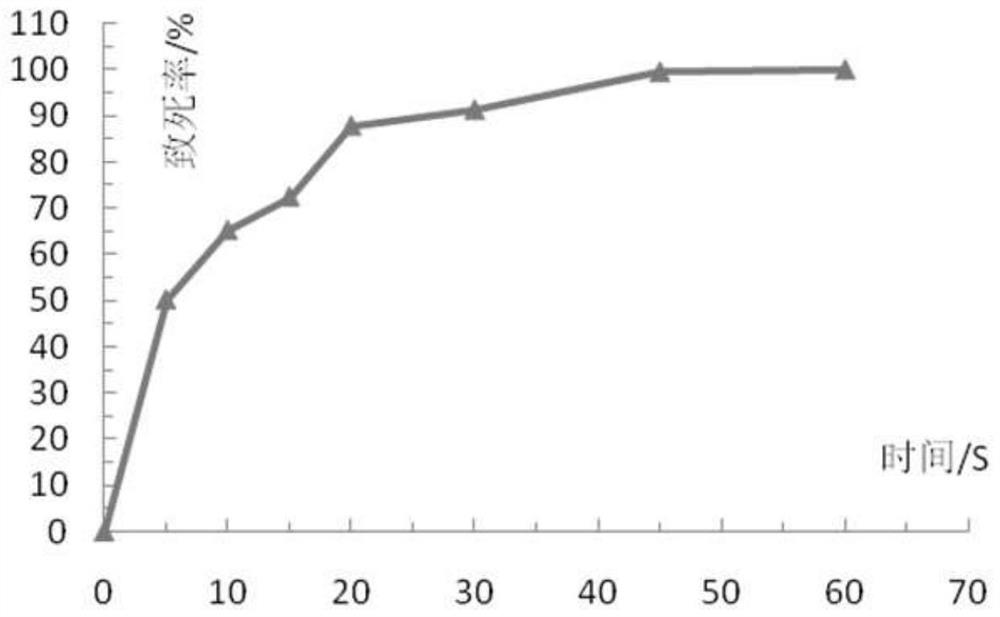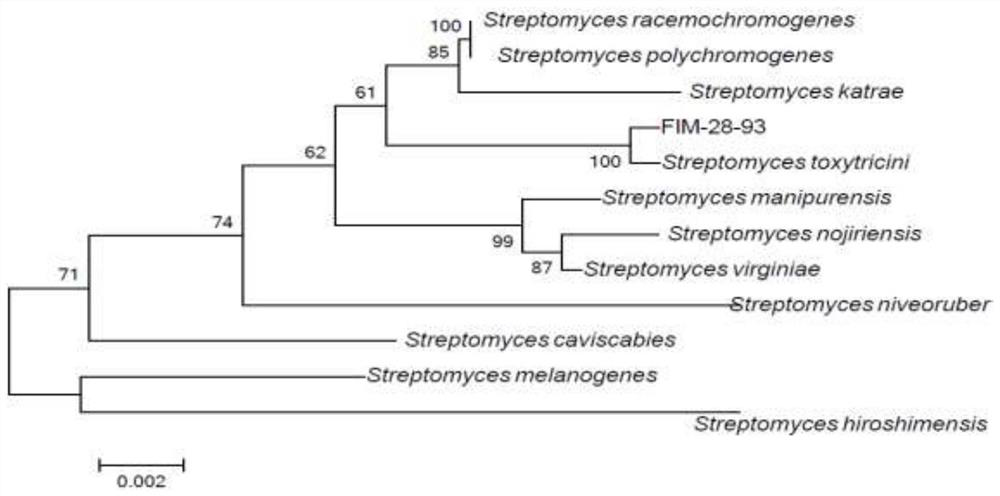Streptomyces toxytricini strain for producing lipstatin through fermentation and application of streptomyces toxytricini strain
A technology of Streptomyces toxin and Lipus, which is applied in the application of fermentative production of lipistatin, and the field of Streptomyces toxins, can solve the problems of unsatisfactory performance of fermentation strains, shorten the fermentation period and increase the yield. , the basic effect of valence
- Summary
- Abstract
- Description
- Claims
- Application Information
AI Technical Summary
Problems solved by technology
Method used
Image
Examples
Embodiment 1
[0030] Example 1 Isolation of starting strain FIM-28
[0031] Soil was collected from a vegetable garden in Jinggang Mountain, Jiangxi Province. Specifically, a sampling shovel was used to remove the floating soil of about 10 cm in the surface layer, and a soil sample of 10 g-25 g was collected at 10 cm; 2 g of the soil sample was weighed and added with 10 mL of sterile saline. Set it for 30min, take the supernatant, i.e. the stock solution, and carry out gradient dilution with sterile normal saline. The dilution is 10. -2 , 10 -3 , 10 -4 and 10 -5 suspension.
[0032] Take 0.1 mL of the stock solution and the selected suspension and spread them on the separation plate medium prepared by adding 50 mg / L potassium dichromate water, repeat 3 parallel plates for each sample, and then place the coated plate on 28 Cultivated at ℃, and observed the morphological characteristics of the colony, such as appearance, size, color, edge shape, and surface dry and wet state.
[0033] Un...
Embodiment 2
[0034]Example 2 Acquisition of mutant strain FIM-28-93
[0035] The strain FIM-28 screened above was taken and transferred to the slant medium, and cultivated in a constant temperature incubator for 6-10 d, and the culture temperature was 30°C; Glass beads are scattered, filtered through gauze, and made into 10 6 spore suspension per mL.
[0036] Use a pipette to suck 10 μL of the spore suspension prepared above on a circular iron sheet with a diameter of 1 cm, and place it in a normal-pressure room-temperature plasma induction chamber with helium as the working gas, a power supply of 110 W, and a working gas flow of 10 L / min. In the variable system, and the treatment distance is 2mm, the treatment is carried out for 5s, 10s, 15s, 20s, 30s, 45s, and 60s, respectively, and the treated spore suspension is diluted and spread on a plate to make a lethality curve (such as figure 1 shown). from figure 1 It can be seen that there is an obvious dose-effect relationship between the...
Embodiment 3
[0042] Example 3 Identification of strain FIM-28-93
[0043] Physiological and biochemical characteristics identification
[0044] The obtained strain FIM-28-93 was streaked on the separation medium plate and inserted into a cover glass, cultured at 28 °C for 7-20 d, and the morphological characteristics of a single colony and its bacteria were observed by optical microscope, transmission and scanning electron microscope. Silk.
[0045] The main morphological and physiological and biochemical characteristics of the strain FIM-28-93 are as follows: the colony on the plate is round, the center is pale pink, the outside is pale pink, the hyphae in the base are colorless, brown soluble pigment, and the aerial hyphae are Pink, producing a large number of spores; gelatin liquefies slowly, milk coagulates first, and then slowly peptonizes; starch can be hydrolyzed, but does not grow on cellulose; nitrate reduction is weak, and D-glucose can be used. This strain FIM-28-93 is a highl...
PUM
 Login to View More
Login to View More Abstract
Description
Claims
Application Information
 Login to View More
Login to View More - R&D
- Intellectual Property
- Life Sciences
- Materials
- Tech Scout
- Unparalleled Data Quality
- Higher Quality Content
- 60% Fewer Hallucinations
Browse by: Latest US Patents, China's latest patents, Technical Efficacy Thesaurus, Application Domain, Technology Topic, Popular Technical Reports.
© 2025 PatSnap. All rights reserved.Legal|Privacy policy|Modern Slavery Act Transparency Statement|Sitemap|About US| Contact US: help@patsnap.com


